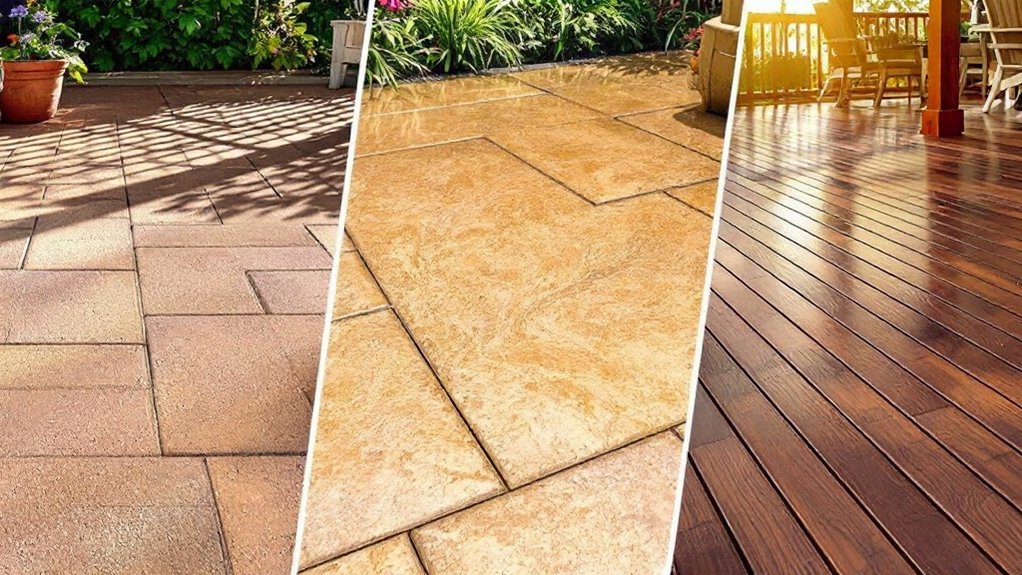Choosing the right decking material can greatly impact a homeowner’s outdoor space. Pavers, travertine, and wood composites each offer distinct characteristics. Pavers are known for durability and design options. Travertine provides a natural aesthetic and effective drainage. Meanwhile, wood composites resemble traditional wood but require less upkeep. Understanding these differences is essential for making an informed decision. What factors will ultimately influence the choice between these materials?
Overview of Decking Materials
When choosing decking materials, homeowners often consider various options that balance aesthetics, durability, and maintenance. Among the popular choices are pavers, travertine, and wood composites, each offering distinct characteristics. Pavers, typically made from concrete or stone, provide a robust surface that can withstand heavy foot traffic and environmental conditions. Travertine, a natural stone, is favored for its elegant appearance and natural cooling properties, making it ideal for warm climates. Wood composites, a blend of recycled wood fibers and plastic, offer the look of traditional wood without the extensive maintenance requirements. Each material presents unique benefits and challenges, influencing homeowners’ decisions based on individual preferences and project specifications, ultimately shaping outdoor living spaces. Additionally, selecting energy-efficient materials can contribute to long-term cost savings and enhance overall economic stability for households.
Benefits of Pavers
Pavers offer significant advantages regarding durability and longevity, making them a reliable choice for outdoor spaces. Their resistance to weathering and wear guarantees that they maintain their aesthetic appeal over time. Additionally, the design versatility of pavers allows homeowners to create customized looks that suit various architectural styles. Furthermore, incorporating effective policies can encourage the use of sustainable materials in landscaping projects.
Durability and Longevity
Although the choice of decking material can greatly impact outdoor aesthetics, durability and longevity are paramount considerations for any homeowner. Pavers stand out for their resilience, often lasting decades with minimal maintenance. They are designed to withstand harsh weather conditions, heavy foot traffic, and the weight of furniture, making them an excellent choice for outdoor spaces. Unlike wood composites, which may suffer from warping or fading, pavers maintain their structural integrity and color over time. Additionally, they are resistant to pests and rot, further enhancing their longevity. When properly installed, pavers can provide a stable, durable surface that endures the test of time, offering homeowners a reliable investment for their outdoor areas.
Design Versatility Options
While homeowners often seek aesthetic appeal in their outdoor spaces, the design versatility of pavers offers numerous advantages that extend beyond mere looks. Pavers come in a wide range of materials, colors, shapes, and textures, allowing for tailored designs that can match any architectural style. This adaptability makes it easy to create custom patterns or borders, enhancing the visual interest of patios and pathways. In addition, pavers can be easily rearranged or replaced if damage occurs, maintaining the overall design’s integrity. Their ability to accommodate various landscaping styles, from modern to rustic, adds to their appeal. With pavers, homeowners can achieve a unique outdoor environment that reflects personal taste while benefiting from practical functionality.
Advantages of Travertine
Travertine offers a unique natural aesthetic that enhances outdoor spaces with its distinctive textures and colors. Its durability and longevity make it an ideal choice for decking, capable of withstanding various weather conditions without significant wear. As homeowners seek lasting beauty and functionality, travertine stands out as a compelling option. Additionally, investing in building efficiency through materials like travertine can contribute to substantial energy savings in outdoor environments.
Natural Aesthetic Appeal
The natural aesthetic appeal of travertine sets it apart as a favored choice for outdoor spaces. With its unique textures and earthy tones, travertine creates a warm, inviting atmosphere that complements various architectural styles. Its natural variations in color—from soft creams to rich browns—add depth and character, ensuring that each installation is distinctly individual. Additionally, the stone’s ability to blend seamlessly with surrounding landscapes enhances its visual charm. Travertine’s refined look evokes a sense of luxury while maintaining a rustic essence, making it suitable for patios, walkways, and pool areas. Overall, its timeless beauty and organic allure make travertine a compelling option for homeowners seeking to elevate their outdoor aesthetic.
Durability and Longevity
Renowned for its striking beauty, travertine also boasts remarkable durability and longevity. This natural stone is resistant to heat and moisture, making it an ideal choice for outdoor spaces exposed to the elements. Unlike wood composites, which can warp or fade over time, travertine maintains its integrity and aesthetic appeal. Its porous nature allows for natural drainage, reducing the risk of slipping in wet conditions. Additionally, travertine is less prone to damage from pests and does not require the regular maintenance that wood often demands. With proper installation and care, travertine can last for decades, providing homeowners with a long-lasting, elegant solution for their decking needs. This unique combination of durability and beauty positions travertine as a superior choice in outdoor materials.
Features of Wood Composites
Wood composites offer a blend of durability and aesthetic appeal, making them a popular choice for outdoor decking solutions. These materials are typically made from a combination of wood fibers and recycled plastic, resulting in a product that mimics the look of natural wood while providing enhanced resistance to weather, UV rays, and insects. The versatility of wood composites allows for various colors and finishes, catering to diverse design preferences. Additionally, they often feature slip-resistant surfaces, promoting safety in wet conditions. Their dimensional stability minimizes warping and splitting, ensuring a consistent appearance over time. Overall, wood composites provide an attractive, low-maintenance alternative to traditional wood, appealing to homeowners looking for both functionality and style in their outdoor spaces. Moreover, their sustainable composition aligns with the principles of deep decarbonization, contributing positively to environmental efforts.
Maintenance Considerations
Choosing wood composites for decking brings the benefit of reduced maintenance compared to traditional wood options. Unlike wood, which requires regular staining, sealing, and treatments to protect against moisture and pests, wood composites are designed to resist these issues. They do not splinter, warp, or fade as easily, leading to less frequent replacement and repairs. In contrast, travertine pavers may require periodic sealing to prevent staining and maintain their appearance, while also necessitating efforts to manage weeds in joints. Regular cleaning for all decking options is essential, but wood composites can often be cleaned with just soap and water. Overall, wood composites provide an attractive, low-maintenance solution that can save homeowners time and effort in upkeep. Additionally, investing in energy-efficient technologies can lead to significant savings in utility bills and contribute to a more sustainable environment.
Cost Comparison and Budgeting
When evaluating decking options, the cost is a crucial factor that can influence a homeowner’s decision. Pavers generally range from $3 to $15 per square foot, depending on material quality and installation complexity. Travertine, while offering elegance, tends to be pricier, averaging between $5 and $20 per square foot, alongside additional installation costs. Wood composites present a middle ground, with prices typically between $2 and $13 per square foot, factoring in their durability and low maintenance. Homeowners should also consider long-term expenses, such as maintenance and potential replacement costs, which can vary greatly across these options. Budgeting effectively requires an analysis of both initial investments and ongoing expenditures to guarantee a choice that aligns with financial capabilities and lifestyle preferences.
Frequently Asked Questions
What Are the Best Decking Options for Wet Climates?
In wet climates, the best decking options include composite materials, which resist moisture and decay, as well as treated wood that withstands humidity. Additionally, paving stones provide excellent drainage and durability against water exposure.
How Do Pavers Compare to Natural Stone in Durability?
Pavers generally offer superior durability compared to natural stone, as they are resistant to cracking and chipping. However, natural stone can provide a longer lifespan if properly maintained, showcasing its natural beauty over time.
Can Wood Composites Be Painted or Stained?
Wood composites can be painted or stained, but results may vary based on the product’s surface and composition. Proper preparation is essential for adhesion and durability, making it important to follow manufacturer guidelines for best results.
Are There Eco-Friendly Options Available for Decking Materials?
Yes, there are eco-friendly options available for decking materials. Bamboo, recycled plastic, and sustainably sourced wood are popular choices. These materials minimize environmental impact while providing durability and aesthetic appeal for outdoor spaces.
What Is the Lifespan of Each Decking Material?
Pavers typically last 25-50 years, travertine can endure 50-100 years, while wood composites generally have a lifespan of 25-30 years. Factors such as maintenance, climate, and installation quality greatly influence these durations.
Conclusion
To sum up, selecting the right decking material depends on individual preferences and practical considerations. Pavers stand out for their durability and versatility, while travertine adds a touch of natural elegance and effective drainage. Wood composites offer a low-maintenance alternative that captures the essence of traditional wood. By evaluating the benefits of each option alongside maintenance needs and budget constraints, homeowners can make an informed decision that enhances their outdoor spaces and meets their lifestyle requirements.

